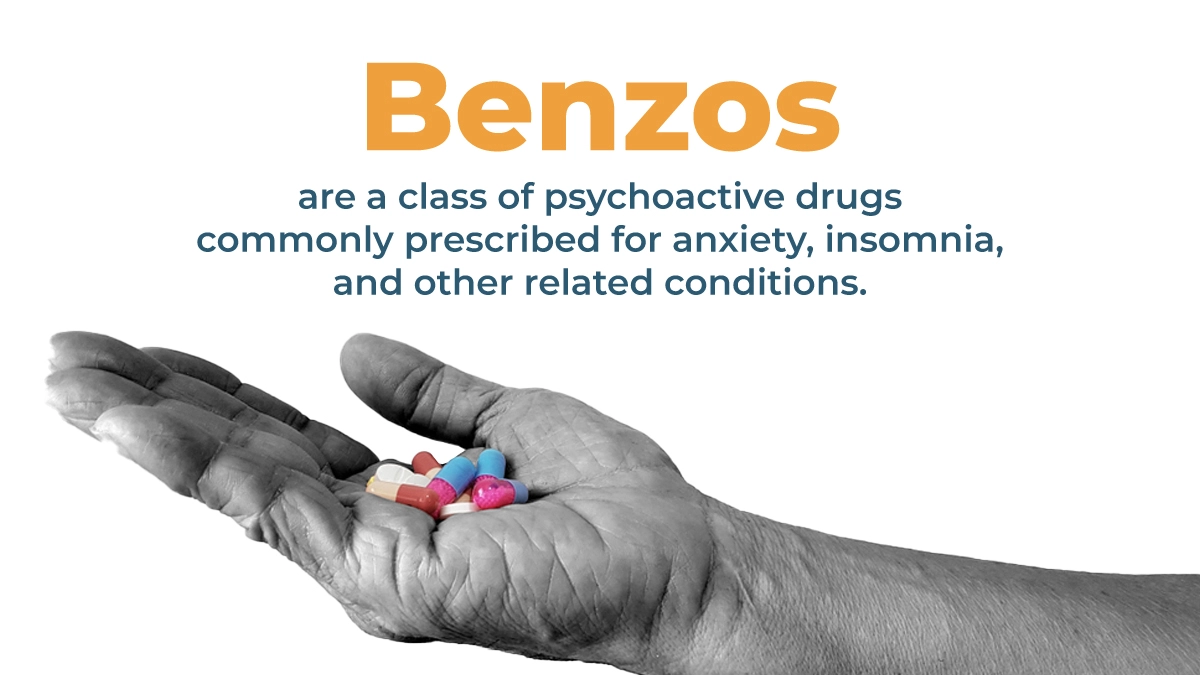
A Guide To Repairing Family Relationships
Discover expert tips for repairing family relationships and fostering healthy connections with The Recovery Team.

Benzodiazepines, commonly known as “benzos,” are a class of psychoactive drugs that exert powerful sedative, hypnotic, anxiolytic, muscle relaxant, and anticonvulsant effects. These medications act on the central nervous system by enhancing the neurotransmitter gamma-aminobutyric acid (GABA) effects.
Despite their therapeutic benefits, the potential for dependence and addiction has raised concerns, leading to careful prescription practices to balance their efficacy with associated risks.
Prolonged use of benzodiazepines can lead to the development of tolerance, dependence, and withdrawal symptoms upon discontinuation. Here’s what you need to know:
Contact The Recovery Team at (800) 817-1247 for information and medical support to foster long-term healing.
Benzodiazepines, a class of depressant drugs, have a rich but controversial history. The story begins in the 1950s when Leo Sternbach, a chemist at Hoffmann-La Roche, synthesized chlordiazepoxide, the first benzodiazepine.
This discovery marked a revolutionary advancement in treating anxiety and insomnia. Valium (diazepam), introduced in the 1960s, became a cultural icon and one of the most prescribed drugs globally.
However, over time, concerns emerged about benzodiazepine dependence and abuse. The 1970s and 1980s saw a surge in prescriptions, contributing to rising addiction rates. Medical professionals started reevaluating their usage, especially as withdrawal symptoms and long-term cognitive effects became evident.
Benzodiazepines are categorized based on their pharmacological properties, duration of action, and clinical uses.
Here are some categories of benzodiazepines:
Short-Acting Benzodiazepines: Characterized by a rapid onset and short duration of action, short-acting benzodiazepines are often prescribed for conditions requiring quick relief, such as acute anxiety or panic attacks. Examples include alprazolam and triazolam.
Intermediate-Acting Benzodiazepines: This category comprises benzodiazepine substances with moderate onset and duration of action. They are commonly used for generalized anxiety disorders and certain sleep disorders. Diazepam and lorazepam are prominent members of this group.
Long-Acting Benzodiazepines: Long-acting benzodiazepines have a slower onset and a more prolonged duration of action, making them suitable for conditions requiring sustained relief, such as chronic anxiety or insomnia. Examples include clonazepam and flurazepam.
Anxiolytic vs. Hypnotic Benzodiazepines: Benzodiazepines can be further classified based on their primary therapeutic effects. Anxiolytic benzodiazepines, like diazepam and lorazepam, are primarily used to alleviate anxiety. Hypnotic benzodiazepines, such as triazolam and flurazepam, are prescribed to induce and maintain sleep.
Benzodiazepines are a class of psychoactive drugs that exert their effects by enhancing the activity of a neurotransmitter called gamma-aminobutyric acid (GABA) in the brain. GABA is the primary inhibitory neurotransmitter in the central nervous system, meaning it reduces the activity of nerve cells and helps regulate excessive neural firing. Here’s a more detailed explanation of how benzodiazepines work:
Benzos bind to a specific site on the GABA-A receptor, a type of GABA receptor. GABA-A receptors are ion channels that allow chloride ions to enter the neuron, leading to cell membrane hyperpolarization.
This hyperpolarization makes it more difficult for the neuron to reach its threshold and fire an action potential, reducing the likelihood of the neuron transmitting signals.
Benzodiazepines do not directly activate the GABA-A receptor. Instead, they bind to a site on the receptor that is distinct from the GABA binding site. This binding enhances the effect of GABA when it binds to its receptor.
In the presence of GABA and benzodiazepines, the GABA-induced chloride influx into the neuron increases, leading to a stronger inhibitory effect.
The enhanced GABAergic activity of benzodiazepines increases chloride ions’ flow into the neuron. This hyperpolarization makes it more challenging for the neuron to depolarize and generate an action potential. As a consequence, the overall excitability of the neuron is reduced.
The cumulative effect of benzodiazepines on GABAergic neurotransmission is a general suppression of the central nervous system (CNS). This CNS depression leads to various pharmacological effects, including anxiolytic (anxiety-reducing), sedative, hypnotic (sleep-inducing), muscle relaxant, and anticonvulsant properties.
Benzodiazepines have a range of therapeutic uses due to their ability to enhance the effect of the neurotransmitter gamma-aminobutyric acid (GABA) in the brain. GABA is an inhibitory neurotransmitter, meaning it decreases the activity of nerve cells in the brain.
Here are some common uses of benzodiazepines:
Benzodiazepines are often given to treat anxiety disorders, panic disorders, and acute episodes of anxiety. They work by calming excessive neuronal activity in the brain, helping to alleviate anxiety and tension.
Benzodiazepines have soothing properties, making them useful for promoting relaxation and sleep. They are prescribed for short-term treatment of insomnia, especially when the insomnia is related to anxiety.
In higher doses, some benzodiazepines can act as hypnotics, inducing and maintaining sleep. These drugs may be used to treat insomnia, although they are generally recommended for short-term use due to the risk of dependence.
Benzodiazepines can be prescribed as muscle relaxants to alleviate muscle spasms and stiffness. They work by inhibiting excessive muscle activity through their effects on the central nervous system.
Some benzodiazepines are used as adjuncts in the treatment of certain types of seizures, particularly in emergencies or when other anticonvulsant medications are ineffective.
Benzodiazepines are sometimes used to manage symptoms of alcohol withdrawal, such as anxiety, tremors, and seizures. They help stabilize the central nervous system during the detoxification process.
Benzodiazepines may be used as premedication before surgery to reduce anxiety and induce relaxation in patients.
Informed benzodiazepine use is crucial due to the potential risks and benefits associated with these medications. Here are some key reasons why informed benzodiazepine use is important:
Benzos have the potential for dependence and addiction, especially when used over an extended period. Informed use involves understanding the risk of developing tolerance (requiring high doses for the same effect) and withdrawal symptoms when stopping or reducing the medication.
Benzodiazepines can cause side effects, including drowsiness, dizziness, impaired coordination, memory issues, and even death. Informed use requires individuals to be aware of potential side effects and promptly report any adverse reactions to their healthcare providers.
Benzodiazepines can interact with other medications, leading to increased or decreased effects. To avoid potentially harmful interactions, people must inform their healthcare providers about all medications, including over-the-counter drugs and supplements.
Prolonged use of benzodiazepines has been associated with cognitive impairment, particularly in older adults. Informed use involves weighing the potential benefits of the medication against the risks, especially in long-term use.
Abrupt discontinuing benzodiazepines can lead to withdrawal symptoms, which can be severe. Informed use requires a gradual tapering process under the supervision of a healthcare provider to minimize withdrawal symptoms and prevent complications.
Take the first step to rediscover the joy of a drug-free life with our comprehensive addiction treatment programs.
Our tailored services provide a holistic approach to recovery, ensuring a smooth transition toward a healthier, addiction-free lifestyle. In addition, our Cognitive Behavioral Therapy (CBT) approach empowers individuals to identify and change destructive thought patterns, fostering lasting recovery.
Contact us at (800) 817-1247 today to start your transformative healing process.

Discover expert tips for repairing family relationships and fostering healthy connections with The Recovery Team.

Discover practical tips on how to set boundaries with people in this expert guide from The Recovery Team.

Naloxone saves lives. The Recovery Team shares how to reverse an opioid overdose with this drug.
Benzodiazepines can be effective in treating symptoms of anxiety and insomnia, but their long-term use is associated with dependence and withdrawal symptoms. Long-term use of benzodiazepines can lead to addiction and adverse effects, including respiratory depression.
While beneficial when prescribed and monitored carefully, caution is necessary due to potential risks. Consult healthcare professionals to weigh benefits against potential drawbacks and explore alternative treatments for certain conditions.
Benzodiazepines, used for anxiety and insomnia, can cause drowsiness, dizziness, and coordination issues. Long-term use of benzodiazepine receptors may lead to dependence, withdrawal symptoms, panic disorder, and memory impairment.
They can also increase the risk of falls, respiratory distress, and paradoxical reactions. Combining with alcohol or other dangerous drugs intensifies risks. Consult a doctor for personalized medical advice.
Benzodiazepines, prescription sedatives, and Class C drugs are central nervous system depressants with a potential for addiction. Common side effects of high doses include drowsiness and dizziness, paranoia, and other health problems.
Street benzos, obtained illegally, pose risks for young adults. The drugs, with varying half-lives, can lead to dependence and should be managed cautiously to avoid adverse reactions.